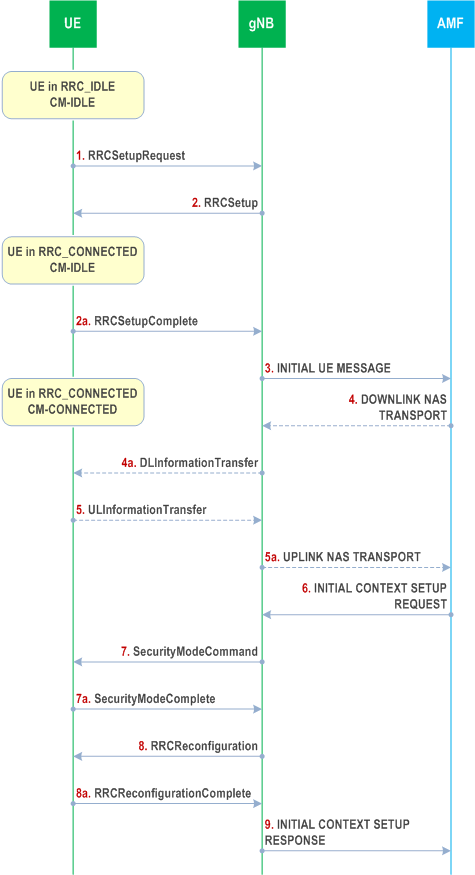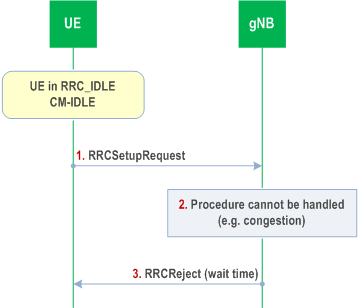Content for TS 38.300 Word version: 18.0.0
1…
4…
4.7…
5…
5.3…
5.4…
6…
6.2…
6.6…
7…
8…
9…
9.2.2…
9.2.2.5…
9.2.3…
9.2.3.2…
9.2.3.3…
9.2.4…
9.2.6…
9.3…
10…
11…
15…
15.5…
16…
16.2…
16.3…
16.4…
16.8…
16.9…
16.10…
16.12…
16.12.5…
16.12.6…
16.12.6.3
16.12.7
16.13…
16.14…
16.15…
16.18…
16.19…
16.21…
16.21.3…
17…
18…
19
20…
21…
A…
B…
C…
G…
9 Mobility and State Transitions
9.1 Overview
9.2 Intra-NR
9.2.1 Mobility in RRC_IDLE
9.2.1.1 Cell Selection
9.2.1.2 Cell Reselection
9.2.1.3 State Transitions
...
...
9 Mobility and State Transitions p. 74
9.1 Overview p. 74
Load balancing is achieved in NR with handover, redirection mechanisms upon RRC release and through the usage of inter-frequency and inter-RAT absolute priorities and inter-frequency Qoffset parameters.
Measurements to be performed by a UE for connected mode mobility are classified in at least four measurement types:
- Intra-frequency NR measurements;
- Inter-frequency NR measurements;
- Inter-RAT measurements for E-UTRA;
- Inter-RAT measurements for UTRA.
- Associate several reporting configurations to one measurement object and;
- Associate one reporting configuration to several measurement objects.
9.2 Intra-NR p. 75
9.2.1 Mobility in RRC_IDLE p. 75
9.2.1.1 Cell Selection p. 75
The principles of PLMN selection in NR are based on the 3GPP PLMN selection principles. Cell selection is required on transition from RM-DEREGISTERED to RM-REGISTERED, from CM-IDLE to CM-CONNECTED and from CM-CONNECTED to CM-IDLE and is based on the following principles:
- The UE NAS layer identifies a selected PLMN and equivalent PLMNs;
-
Cell selection is always based on CD-SSBs located on the synchronization raster (see clause 5.2.4):
-
The UE searches the NR frequency bands and for each carrier frequency identifies the strongest cell as per the CD-SSB. It then reads cell system information broadcast to identify its PLMN(s):
- The UE may search each carrier in turn ("initial cell selection") or make use of stored information to shorten the search ("stored information cell selection").
-
The UE searches the NR frequency bands and for each carrier frequency identifies the strongest cell as per the CD-SSB. It then reads cell system information broadcast to identify its PLMN(s):
-
The UE seeks to identify a suitable cell; if it is not able to identify a suitable cell it seeks to identify an acceptable cell. When a suitable cell is found or if only an acceptable cell is found it camps on that cell and commence the cell reselection procedure:
- A suitable cell is one for which the measured cell attributes satisfy the cell selection criteria; the cell PLMN is the selected PLMN, registered or an equivalent PLMN; the cell is not barred or reserved and the cell is not part of a tracking area which is in the list of "forbidden tracking areas for roaming";
- An acceptable cell is one for which the measured cell attributes satisfy the cell selection criteria and the cell is not barred.
-
The IAB-MT and NCR-MT apply the cell selection procedure as described for the UE with the following differences:
- The IAB-MT and NCR-MT ignore cell-barring or cell-reservation indications contained in cell system information broadcast;
- The IAB-MT only considers a cell as a candidate for cell selection if the cell system information broadcast indicates IAB support for the selected PLMN or the selected SNPN, and the NCR-MT only considers a cell as a candidate for cell selection if the cell system information broadcast indicates Network-Controlled Repeater support.
-
The mobile IAB-MT applies the cell selection procedure as described for the IAB-MT with the following differences:
- The mobile IAB-MT only considers a cell as a candidate cell for cell selection if the cell system information broadcast indicates mobile IAB support.
- On transition from RRC_CONNECTED or RRC_INACTIVE to RRC_IDLE, a UE should camp on a cell as result of cell selection according to the frequency be assigned by RRC in the state transition message if any.
- The UE should attempt to find a suitable cell in the manner described for stored information or initial cell selection above. If no suitable cell is found on any frequency or RAT, the UE should attempt to find an acceptable cell.
9.2.1.2 Cell Reselection p. 76
A UE in RRC_IDLE performs cell reselection. The principles of the procedure are the following:
- Cell reselection is always based on CD-SSBs located on the synchronization raster (see clause 5.2.4).
-
The UE makes measurements of attributes of the serving and neighbour cells to enable the reselection process:
- For the search and measurement of inter-frequency neighbouring cells, only the carrier frequencies need to be indicated.
-
Cell reselection identifies the cell that the UE should camp on. It is based on cell reselection criteria which involves measurements of the serving and neighbour cells:
- Intra-frequency reselection is based on ranking of cells;
- Inter-frequency reselection is based on absolute priorities where a UE tries to camp on the highest priority frequency available;
- A Neighbour Cell List (NCL) can be provided by the serving cell to handle specific cases for intra- and inter-frequency neighbouring cells;
- Exclude-lists can be provided to prevent the UE from reselecting to specific intra- and inter-frequency neighbouring cells;
- Allow-lists can be provided to request the UE to reselect to only specific intra- and inter-frequency neighbouring cells;
- Cell reselection can be speed dependent;
- Service specific prioritisation;
- Slice-based cell reselection information can be provided to facilitate the UE to reselect a cell that supports specific slices.
9.2.1.3 State Transitions p. 76
The following Figure describes the UE triggered transition from RRC_IDLE to RRC_CONNECTED (for the NAS part, see TS 23.502):

Step 1.
The following Figure describes the rejection from the network when the UE attempts to setup a connection from RRC_IDLE:
The UE requests to setup a new connection from RRC_IDLE.
Step 2/2a.
The gNB completes the RRC setup procedure.
Step 3.
The first NAS message from the UE, piggybacked in RRCSetupComplete, is sent to AMF.
Step 4/4a/5/5a.
Additional NAS messages may be exchanged between UE and AMF, see TS 23.502.
Step 6.
The AMF prepares the UE context data (including PDU session context, the Security Key, UE Radio Capability and UE Security Capabilities, etc.) and sends it to the gNB.
Step 7/7a.
The gNB activates the AS security with the UE.
Step 8/8a.
The gNB performs the reconfiguration to setup SRB2 and DRBs for UE, or SRB2 and optionally DRBs for IAB-MT.
Step 9.
The gNB informs the AMF that the setup procedure is completed.
